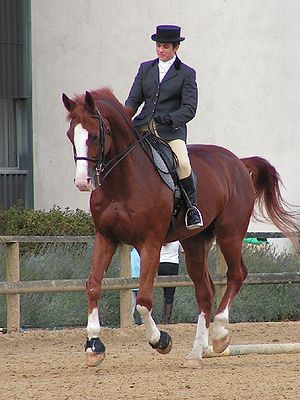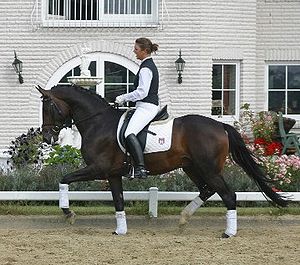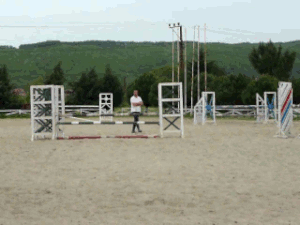 Image via Wikipedia
Image via WikipediaHow To Train A Horse
Dressage isn't just some moves with difficult to utter names. Each time you train your horses to carry out with more ease, and respond to subtle training aids,you are training them in basic dressage. Dressage is teaching a horse to be supple, good balanced and overly responsive.Horse training are quite similar to religion, meaning that even those who hold to the same philosophy don't always agree on every little detail.
People can get quite passionate on their beliefs. Just for the record and in case you're interested, here are a few of my beliefs and practices. That is the best way to train a horse and. That will work on every single horse, every time. What may work well on one horse may have little to no effect on another.
Horse training are those qualities that cannot be completely measured and involve such attributes as a sense of a willing attitude, cooperation and trust, and a sense of respect. Definite goals always involve performance of specific maneuvers and tasks such as cantering on the correct lead, clearing a 4 foot fence, or standing still when you mount.
The best plan is to begin lead training with your horse when he is still a foal. Don't leave it too late to begin teaching ground manners – a young horse doesn't necessarily need to know about saddles and riding yet, so you have time to focus on these very important basics. Cooperation will still be needed from the young horse during vet or farrier visits, as well as for other people he may come into contact with.
Lead training is made easier if the dam is with you as the foal will automatically mirror the behaviors of it's mother. Even if the dam is not on site, the foal will copy any other horse with which he spends time. Young horses naturally learn from the older ones in the herd. For example, you don't need to teach a horse in the pasture how to graze or go to the water and drink.
Firstly you need to look at the reasons why horses can be difficult when handling their feet. Horses first line of defense is to run away, this is difficult if we have hold of a foot! He feels vulnerable.The horse has not been taught properly how to lift his feet.Maybe he has been mishandled in the past when having his feet lifted.
CLICK HERE FOR MORE
INFORMATION ON How To Train A Horse
Slowly associate leg commands with the corresponding rein commands by asking for both simultaneously. When you try to put pressure on your left rein to turn your horse left, nudge your horse gently with your right calf.Decide which commands to use or should mean what. If you would want your horse to stop when you apply pressure with your heels (common in many western disciplines), apply this in a consistent manner to prevent confusion.Remove pressure in your leg when your horse starts to know commands. If you try to give him leg and he walks forward, urgently remove the leg pressure to effectively communicate that he's done what you asked.
Start with the front legs: To begin with stroke the horse on the neck and slowly make your way down to the shoulder, if he is happy and hasn’t moved away, stop and take your hand away. Then gradually work your way down the front leg, taking your hand away each time you go a little further, to reward him, giving him a good stroke is also nice. Working like this you will be able to touch all the way down the leg to the hoof, with the horse remaining completely relaxed. Once you find that you can just get to the knee during the initial sessions, that’s just fine, finish on a nice note and attempt to get further down the leg in the subsequent session.
When working on the back legs: use the same technique, but with the false arm. If the horse kicks out or steps away, try to keep the arm on, or at least near, the leg. Whenever the horse stops, take the arm away to reward the horse for doing the right thing (in this case stopping kicking or moving away). Whilst doing this work keep yourself calm and relaxed, as this will also help the horse. As with the front legs it will not be long before you are able to touch all the way down the back legs and around the fetlock area with the false arm.
As with the back legs, using the padded walking stick,gently stroke down the leg and hook the curved handle around the fetlock, you may use a rope. Slowly pull forward, whenever the horse lifts his foot immediately put it down and remove the walking stick. Repeat this a few times, gradually increasing the time you have the foot lifted. When you are happy with how the horse is dealing with this, lift his foot with your hand, but do, at this stage, lift it by pulling forward as you did with the walking stick.Once the horse is happy having his feet lifted and held up you can start to get him used to having them held as the farrier would hold them. So do take note of the positions that the farrier uses.
Tips & Warnings
*Don't ever kick your horse or jerk on the horse's reins to emphasize a command.HORSE Training takes time, and won't be achieved through fear.
*If someone else would want to ride your horse,see to it they know the commands you've been using.
CLICK HERE FOR MORE
INFORMATION ON How To Train A Horse











